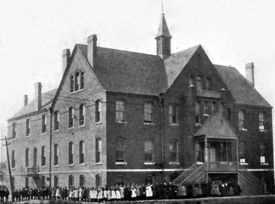St Mark's Academic and Industrial School
St Mark's Academic and Industrial School was a private school founded in 1892 by James Van Hoose, deacon of the Cathedral Church of the Advent and later Mayor of Birmingham, for the education of African American children. The school was the first in Birmingham to offer secondary education to black students. Although it charged a modest tuition, the school was funded primarily by the Episcopal Diocese of Alabama, the Episcopal Board of Missions and the American Church Institute for Negroes.
The school was established on a side street with just 8 students and two teachers, both white women from New York and Michigan, respectively. In 1899 Charles Brooks came to Birmingham from Baltimore, Maryland to serve as pastor at St Mark's Episcopal Church and as principal of the school. High school grades were added under his leadership, and the school awarded its first high school diploma in 1900.
In 1911 the school had 358 students (of which 300 were girls) and eight teachers. All but 8 of the boys and 62 of the girls were in the elementary grades. By 1914 enrollment was reduced to 192, of which 171 were in the elementary grades, and the staff was seven strong. By then a two-story brick building had been completed.
Later a new four-story brick school building was completed on the corner of 18th Street and Avenue D (4th Avenue South) in Southside.
In addition to basic education and literature, the school taught industrial arts and practical courses in cooking, sewing, laundering and housekeeping to students typically destined to work as servants or laborers.
Notable graduates
- Mattie Lula Parham, grandmother of Condoleezza Rice
References
- United States Bureau of Education (1912) Report of the Commissioner of Education Made to the Secretary of the Interior for the Year Ended June 30, 1911. Washington D.C.: Government Printing Office.
- Owen, Thomas McAdory and Marie Bankhead Owen (1921) History of Alabama and Dictionary of Alabama Biography. 4 volumes. Chicago, Illinois: S. J. Clarke Publishing Co.
- Smith, Barbara (1976) St Mark's Academic and Industrial School, 1892-1940. Birmingham. privately printed.
- Fallin, Wilson (1997) The African American Church in Birmingham, Alabama, 1815-1963: A Shelter in the Storm. New York, New York: Garland Publishing. ISBN 0815328834
- Schnorrenberg, Barbara (December 2002) "The Best School for Blacks in the State': St. Mark's Academic and Industrial School, Birmingham, Alabama, 1892-1940." Anglican and Episcopal History. - originally a presentation delivered to the 5th Southern Conference on Women's History in 2000.
